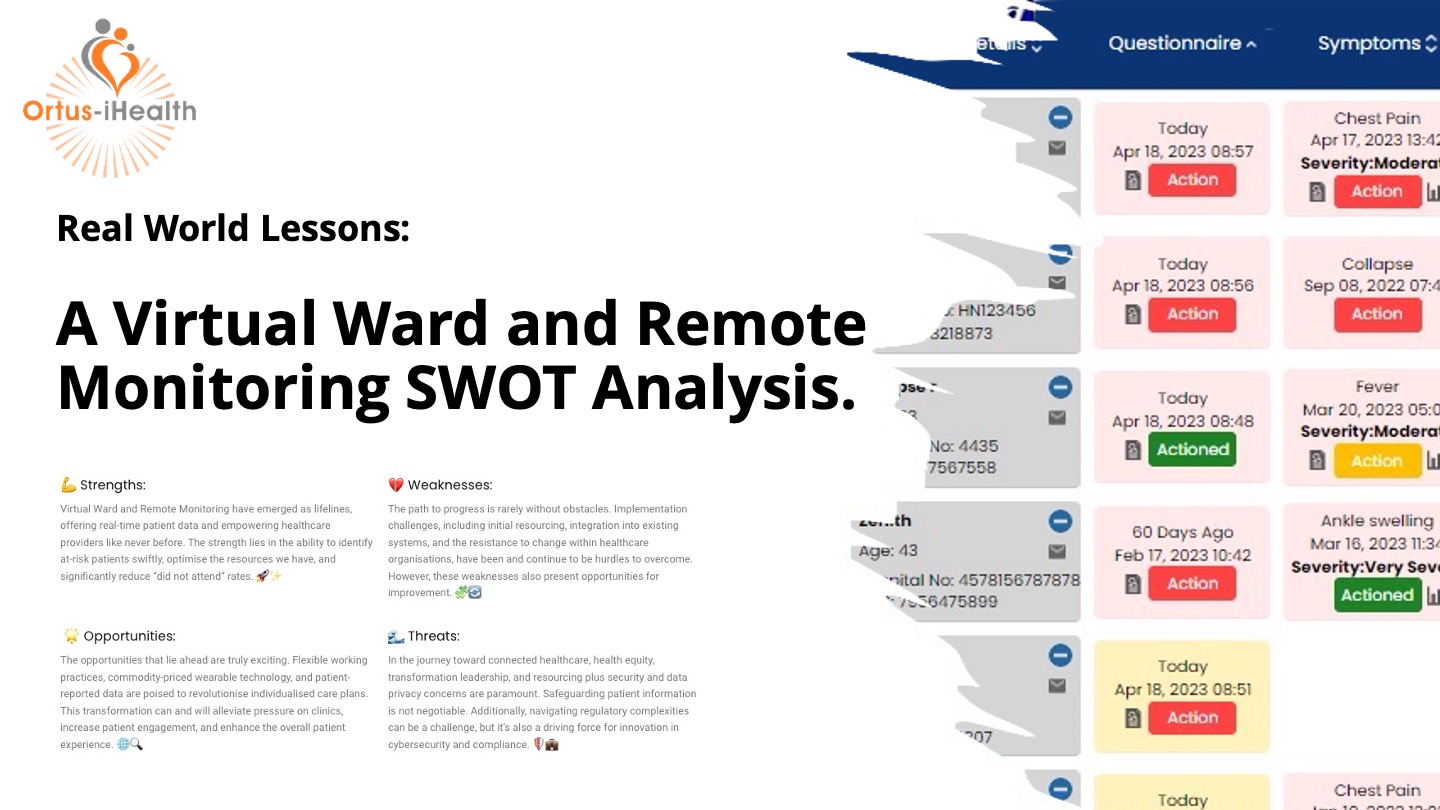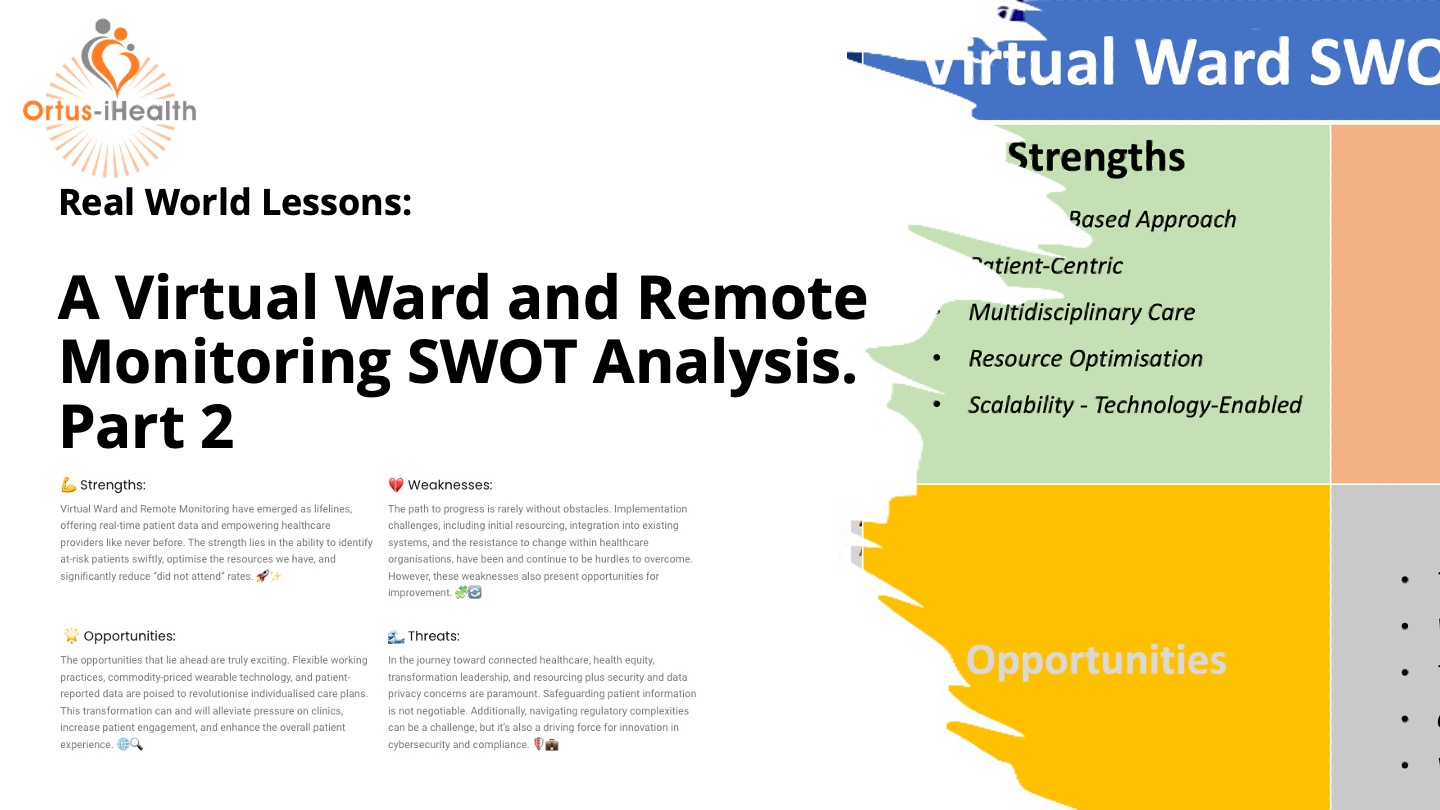Navigating Healthcare’s Future: A SWOT Analysis of Virtual Ward & Remote Monitoring in the UK NHS
A Virtual Ward and Remote Monitoring SWOT Analysis (Part 1 of 3)
As professionals in the healthcare industry, we are witnessing a monumental shift in patient care. The adoption of Virtual Ward and Remote Monitoring technology within the UK NHS has been a game-changer. 🇬🇧💡 In my role at Ortus-iHealth, I’ve had the privilege of witnessing the positive impact of Virtual Ward and Remote Monitoring within our customer base as well as in the wider NHS and patient community. It’s exciting to see how this technology has nudged, and in some areas, started to revolutionise patient care, but there are challenges we need to overcome.
Let’s be real about this; challenges are everywhere, waiting lists are growing, and there is a shortage of resources across the board ranging from staff to hospital beds, and of course, the impact of strike disruption is ever-increasing the fatigue and well-being of those we rely on for service delivery. The inevitable outcome is that patient welfare is put at risk, and it is in that context virtual wards and remote monitoring represent a real opportunity.
At a minimum, we can identify deteriorating patients and prioritise their treatment where appropriate. This puts patient safety at the heart of delivery and, in doing so, reduces unnecessary admissions and enables earlier discharge, freeing up bed capacity, reducing emergency admissions, and enabling the better management and prioritisation of elective care patients.
And no, it doesn’t address the resource issues, but it does give us the opportunity to deliver access to care to those of the highest acuity. It can also be argued that progress is really being made on the path to putting patients at the center of their healthcare journey. 🙌💬
👉 I thought it would be helpful to break down the SWOT analysis of this transformative technology, drawing from both industry insights and personal experiences. So in this first post of 4 I’ll provide a helicopter view of some immediate observations and I’ll be following up with detail in the posts that follow.
💪 Strengths:
Virtual Ward and Remote Monitoring have emerged as lifelines, offering real-time patient data and empowering healthcare providers like never before. The strength lies in the ability to identify at-risk patients swiftly, optimise the resources we have, and significantly reduce “did not attend” rates. 🚀✨
💔 Weaknesses:
The path to progress is rarely without obstacles. Implementation challenges, including initial resourcing, integration into existing systems, and the resistance to change within healthcare organisations, have been and continue to be hurdles to overcome. However, these weaknesses also present opportunities for improvement. 🧩🔄
🌟 Opportunities:
The opportunities that lie ahead are truly exciting. Flexible working practices, commodity-priced wearable technology, and patient-reported data are poised to revolutionise individualised care plans. This transformation can and will alleviate pressure on clinics, increase patient engagement, and enhance the overall patient experience. 🌐🔍
🌊 Threats:
In the journey toward connected healthcare, health equity, transformation leadership, and resourcing plus security and data privacy concerns are paramount. Safeguarding patient information is not negotiable. Additionally, navigating regulatory complexities can be a challenge, but it’s also a driving force for innovation in cybersecurity and compliance. 🛡️💼
What’s Next:
Over the next 2 posts, I’ll run throug the key factors we’ve recognised in our SWOT review and reflect on a number of factors that contribute to the journey ahead including The Strategic Case, National Policy and Guidelines, The Evidence Base and Case Studies and the Local Context as represented by a combiunation of local populations needs and policy.
An Example? The Opportunity for Scalability
The “Scalability” item in the Opportunities section of the SWOT refers to the ability of Virtual Wards to be quickly and safely implemented on a larger scale. This scalability is crucial because of the varying levels of demand experienced during winter and times of crisis such as pandemics. We’ll include reference to evidence which underscores the ability to both enable and facilite scalability, illustrating Virtual Ward and Remote Monitoring’s role as a flexible and adaptable solution for services facing fluctuating levels of demand.
I’d love to hear from you!
What are your thoughts on Virtual Ward and Remote Monitoring? Have you encountered any unique challenges or success stories in your healthcare journey? Please share your questions and thoughts and let’s engage in a meaningful conversation. Share your insights in the comments below! 👇🤝
Part 2 is now available HERE>
Related Posts
Navigating Healthcare’s Future: A SWOT Analysis Part 2: Strengths and Threats!
A Virtual Ward and Remote Monitoring SWOT Analysis: Strengths and Threats (Part 2 of 3) In the first instalment of this three-part series, we touched on the transformative expectations and circumstances surrounding NHS England’s plans for the deployment of Virtual Wards. Programmes of this scale across an organisation as complex and diverse as the NHS [&h




Leave a Reply